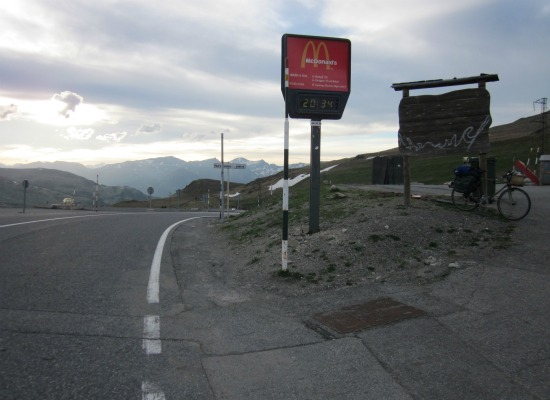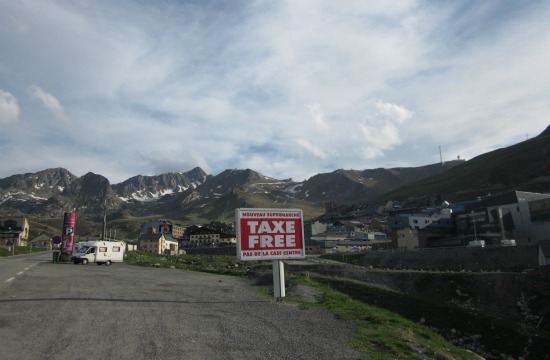Andorra: The Ugliest Country in Europe?
They had green mountains, trout streams and wildflowers; meadows and waterfalls, but Andorrans made their country the least charming in all of Europe
/https://tf-cmsv2-smithsonianmag-media.s3.amazonaws.com/filer/20120614084028AndorraEntrySMALL.jpg)
If there had been a day long ago when the powers that be divided up the land and handed out the properties that would become Europe, I can imagine how the various recipients might have reacted. When the French saw their rolling hills and river valleys, they’d have knelt and handled the soil and declared that good wine would come of this land. And when the Italians saw their forests, they’d have anticipated the truffles and porcini and other wild fungi that would grow there. And when the Norwegians saw their proximity to the North Pole, they’d have known they would lead the world in Arctic exploration. And when the Greeks saw their many islands, they’d have foreseen their role in literature and lore as seafarers.
And when the Andorrans saw the mountainous lands that would be theirs, just upslope of Spain and south of France, I think I know what they’d have said:
“Crummy. It’s going to be tough to build shopping malls up there.”
Because building shopping malls seems to be the primary goal of the people of Andorra, that little landlocked nation smack in the rocky, craggy heart of the Pyrenees. Their secondary objective is apparently to deface their naturally beautiful land in whatever way is most convenient. Credit must be given, for they’ve succeeded in both enterprises. Entering Andorra via France, one encounters the ugliest town in Europe—Pas de la Casa, essentially a shopping complex and ski resort, with huge warehouse-like hotels and supermarkets stacked artlessly like shipping containers along narrow streets, where people eye the identical offerings of a hundred tax free junk stores. Other cement buildings seem abandoned, making them fair game for graffiti enthusiasts. The elevation here is 6,600 feet, and to reach the heart of Andorra, one must either take a highway tunnel south through the mountain or climb another 1300 feet over Col d’Envalira, the highest paved pass in the Pyrenees. I rode over the pass, arriving near sundown. On top was more astonishing ugliness—a handful of gas stations and the would-be spectacular view of the southern mountains nearly eclipsed by a McDonald’s sign posted beside the pass marker. Down the steep highway into the valley, I passed several towns consisting of cheap liquor and clothing outlets with a few hotels and restaurants.

On the highest paved pass in the Pyrenees, Andorra has planted a McDonald's sign---an indication of the country's lenience toward commerce. Photo by Alastair Bland.
The French had warned me that Andorra wasn’t pretty, but I didn’t believe them. How, I wondered, could a mountainous country, located smack between two of the most handsome countries in the world, be dead ugly? But Andorra is, and I would guess that Andorrans, should they read this, will bristle with a sort of pride—because clearly they haven’t sought to make their country pretty to the eye, though they had every chance. They had green mountains, with chamois and trout streams and wildflowers; they had cliffs and meadows and waterfalls; shoot, they even had the prettiest name in Europe, and they squandered it all. For one thing, Andorra has abandoned almost all endeavors agrarian (just 9,000 sheep live here; 100,000 live in the French Pyrenees). And so they grow a little tobacco, import nearly all their food and dedicate themselves to the shopping and services industries. With every slab of concrete they lay and every faux cobblestone they set and every neon light they plug in, they appear to have the goal of marring their landscape. They’ve succeeded grandly.
In France, a traveler may say to himself 30 times a day the following four words: “What a charming village.” In Andorra, such words are not spoken, at least not in that order. Instead, people say, “Cheap cigarettes!” and “Ten pairs of tube socks for 3 Euros!” and “Hooray, they’ve just opened a new perfume outlet in Canillo!”

Mountains, blue sky and sunshine cannot bring redemption to the artificial scenery of Andorra. Here, in the capital city of Andorra la Vella, the chief river of the valley flows over a bed of concrete. Photo by Alastair Bland.
One might say that Andorrans have done the best with what they have—a river canyon cut into a steep and largely rocky mountainside. I’ve seen official documents that call Andorra’s terrain—98 percent of it, to be exact—unsuitable for agriculture, but let’s keep things in context: That land is also unsuitable for perfume outlets and duty free liquor and jewelry shops. And so the Andorrans have crammed all that they hold dear into the available land that flanks their one major highway, which careens at a 10-percent gradient in places from the high pass all the way to Spain. Along the road’s shoulder are chain-link fences and concrete barriers. There are several picnic pullouts which have been carpeted with plastic turf. Billboards and name brands scream at travelers from every direction—McDonald’s, Pepsi and all the rest. But besides commerce, there are resident people here. About 90,000 people enjoy the privilege of calling themselves Andorran. They live in scab-ugly apartment buildings, smog-gray and five stories tall and which permanently block the sunlight from the streets below—which are remarkably noisy for such a small country. Here, Andorrans walk about briskly, attractive and slim as Italians, people who dress sharply, carry glitzy shopping bags and always, it seems, have somewhere to go. There is virtually no unemployment in Andorra. It’s a country both blessed and blistered by prosperity—and they can have it. I had a glance, I had the glory of climbing 6,000 vertical feet to see it, and now I’ve had all I wanted. I am sitting in an Andorran coffee shop now, looking at my map of Spain.
For those of you who don’t care to ever visit Andorra, who could blame you—but here are a few facts and figures on this funny little landlocked nation:
Size: 180 square miles (about four times the size of San Francisco).
Population: 84,300 in 2010.
Capital city: Andorra La Vella, population 22,000—and the highest capital city in Europe, at 3,356 feet.
Main agricultural crop: Tobacco.
Highest point: Coma Pedrosa, 9,665 feet.
Average altitude: 6,000-plus feet.
Wildlife: Includes trout, bears, eagles, chamois, foxes and ducks.
Armed forces: None. (Andorra’s only expense on weaponry is reportedly for ammunition used in ceremonial salutes.)
Main industry: Tourism.
Main tourist draw: Shopping.
Tourists per year: About 10 million.
Restaurants: 400.
Employment: One percent in agriculture, 21 percent in industry, 78 percent in services.
Sheep population: 9,000 (compare to 30 million in New Zealand).
Cow population: 1,100.
Horse population: 200.
/https://tf-cmsv2-smithsonianmag-media.s3.amazonaws.com/accounts/headshot/Off-Road-alastair-bland-240.jpg)

/https://tf-cmsv2-smithsonianmag-media.s3.amazonaws.com/accounts/headshot/Off-Road-alastair-bland-240.jpg)